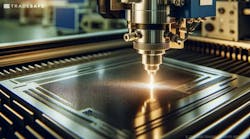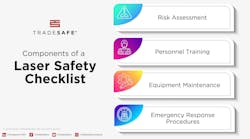Laser safety essentials: A comprehensive checklist for secure operations
Lasers are powerful tools used in many fields, from manufacturing to medicine. But without the right safety measures, they can pose serious hazards from harming people's eyes and skin to even starting fires.
One safety measure to implement when handling laser technology is the use of a comprehensive laser safety checklist. Rich Greene, laser safety consulting and education director at Kentek, cautions that incidents during laser use often occur due to complacency (see Fig. 1), and stresses the importance of using a laser safety checklist to ensure all safety measures are implemented.
Risks of using lasers
Using lasers poses several potential hazards that can cause serious injuries or damage. Below are four common risks:
- Eye injuries. Lasers can cause permanent eye damage or blindness if their light hits the eyes directly.
- Skin burns. High-powered lasers can burn the skin and cause severe injuries.
- Fire hazards. Lasers can ignite flammable materials and cause fires.
- Electrical hazards. Laser equipment often uses high voltage, which posed electrical shock risks.
A laser safety checklist is one way to prevent these risks from turning into incidents. It helps ensure that all necessary precautions are in place and followed, and that guidelines such as the American National Standards Institute’s (ANSI) Z136.1 Laser Safety Standards are adhered to.
The key components of a laser safety checklist include risk assessment, personnel training, equipment maintenance, and emergency response procedures (see Fig. 2).
Conduct a risk assessment for laser safety
Conducting a thorough risk assessment helps identify and address potential hazards. Greene emphasizes that when it comes to risk assessment, it is important to determine what are the laser technologies in the facility, their classifications, and where they are located. This information will help identify the specific control measures that should be implemented in compliance with laser safety standards and guidelines. Below are some important components of a risk assessment process:
Survey your laser equipment and work environment. Start by examining all the laser equipment and the areas where they are used. This includes checking the laser classifications and understanding how they are operated.
Identify potential exposure risks. Identify where and how workers might be exposed to laser hazards. Look for points of direct exposure and reflective surfaces that may pose risks.
Document and analyze findings. Record all identified risks and analyze the data to understand the severity and likelihood of each hazard. Detailed documentation is vital for compliance and ensures that your laser safety checklist is based on real and reliable information.
Implement control measures to mitigate risks. Develop control measures to reduce or eliminate identified risks. This can include using protective barriers, personal protective equipment, and safety interlocks. It is important to check national and state regulations when implementing control measures.
Personnel training is crucial for laser safety
After conducting a thorough risk assessment, the next step in the checklist is ensuring that all personnel are properly trained. Training makes sure that everyone understands the risks and knows how to work safely with lasers. Here are some important topics and components of a laser safety training program:
Understand laser classifications and safety standards. Personnel must be familiar with the different classes of lasers and the specific hazards associated with each one. They should also understand relevant safety standards and guidelines set by the U.S. Occupational Safety and Health Administration (OSHA), the ANSI Z136.1, and the Center for Devices and Radiological Health, among others that provide guidelines for safe laser use.
Use personal protective equipment (PPE). Training should cover the proper use and maintenance of PPE, such as safety goggles and protective clothing. Greene mentions the dangers of exposure to lasers such as an accidental eye injury that can cause a retinal hemorrhage, highlighting the importance of using the correct PPE to protect against laser exposure.
Safe operation and emergency shutdown procedures. Workers need to know how to operate lasers safely and what to do in an emergency. This includes understanding emergency shutdown procedures to quickly stop laser operations if needed.
Regular training sessions and refreshers. It's important to hold regular training sessions and refreshers to keep everyone updated on safety practices. For any questions on laser use and safety, there are resources to contact. Kentek is a resource for general questions about laser safety—whether it’s about protecting eyes or skin, or using other tools and instruments like detectors for near-infrared and ultraviolet laser beams, or power meters.
Maintain laser equipment properly
Proper training is only effective if the laser equipment itself is maintained in optimal condition. Maintaining laser equipment ensures that all safety features function correctly and hazards are minimized. Laser technology maintenance includes:
Routine maintenance and inspection protocols. Regularly scheduled maintenance and inspections are key to better laser safety. These checks help identify any wear and tear or potential issues before they become serious problems. Following a strict maintenance schedule keeps the equipment in top working condition.
Check laser alignment and beam paths. Proper alignment of the laser and its beam path is crucial to prevent accidental exposure. Misaligned lasers can lead to dangerous situations, and Greene points out that misalignment is also one of the common near-misses in the laser industry.
Ensure protective housing and interlocks are intact. The protective housing and interlocks of laser equipment are essential safety features. Regularly inspect these components to guarantee that they are not damaged and are functioning properly.
Regular calibration of laser systems. Calibrating laser systems verifies that they operate within safe parameters. Regular calibration checks are necessary to maintain accurate performance and safety.
Record-keeping of maintenance activities. Keep detailed records of all maintenance activities to help track the history of the equipment, and confirm that all maintenance protocols are followed. This provides a reference for any future issues.
What should your emergency response plan include?
A solid emergency response plan informs everyone what to do in case of an incident and minimizes harm and chaos. These are key features of an effective emergency response plan:
Create emergency plans. Create comprehensive emergency plans tailored to the specific risks associated with your laser equipment. These plans should be easy to follow and readily accessible to all employees.
Take immediate actions when laser incidents occur. Outline the immediate steps to take if a laser incident occurs. This can include shutting down the laser, securing the area, and providing initial care to any affected individuals. Quick and decisive actions can significantly reduce the impact of an incident.
Reporting procedures and first aid. Establish clear reporting procedures for documenting laser incidents. Include protocols for administering first aid, especially for eye injuries. If someone suspects they have been exposed to a laser, according to Greene, they should be taken to an ophthalmologist immediately. The operation should be stopped where the incident occurs, and an accident investigation should begin.
Evacuation plans and emergency contact information. Develop evacuation plans to ensure safe and orderly exits during a serious incident. Make sure emergency contact information is easily accessible to all employees.
Regular drills and evaluations. Conduct regular drills to practice the emergency response plan and evaluate its effectiveness. These drills help identify any weaknesses in the plan and ensure that all employees are prepared.
Laser safety checklist
The components of a comprehensive laser safety checklist are summarized below, which include: risk assessment, personnel training, equipment maintenance, and emergency response procedures.
Conduct a thorough risk assessment:
- Survey laser equipment and environment
- Identify potential exposure risks
- Document and analyze findings
- Implement control measures
Ensure personnel training:
- Train in laser classifications and safety standards
- Use and maintain PPE
- Follow safe operation and emergency procedures
- Schedule regular training sessions and refreshers
Maintain equipment properly:
- Perform routine maintenance and inspections
- Check laser alignment and beam paths
- Ensure protective housing and interlocks
- Calibrate laser systems regularly
- Keep detailed maintenance records
Develop an emergency response plan:
- Create and implement emergency plans
- Define immediate actions for laser incidents
- Establish reporting procedures and first aid steps
- Prepare evacuation plans and emergency contacts
- Conduct regular drills and evaluations
A comprehensive laser safety checklist is essential to prevent accidents and ensure a safe work environment. It covers crucial areas like risk assessment, personnel training, equipment maintenance, and emergency response procedures. By implementing and following a safety checklist, you can minimize hazards and protect everyone in the workplace.
Herbert Post
Herbert Post, Vice President at TRADESAFE, has over 16 years of experience in workplace safety across diverse industrial settings, including manufacturing and petrochemical plants. Raised within a family involved in heavy manufacturing, Herb has a deep-rooted understanding of safety compliance and factory processes. He specializes in continuous and additive manufacturing, developing safety protocols and creating accessible, technical safety resources. Herb's work is widely recognized in industry publications, showcasing his commitment to enhancing safety in high-risk environments.

